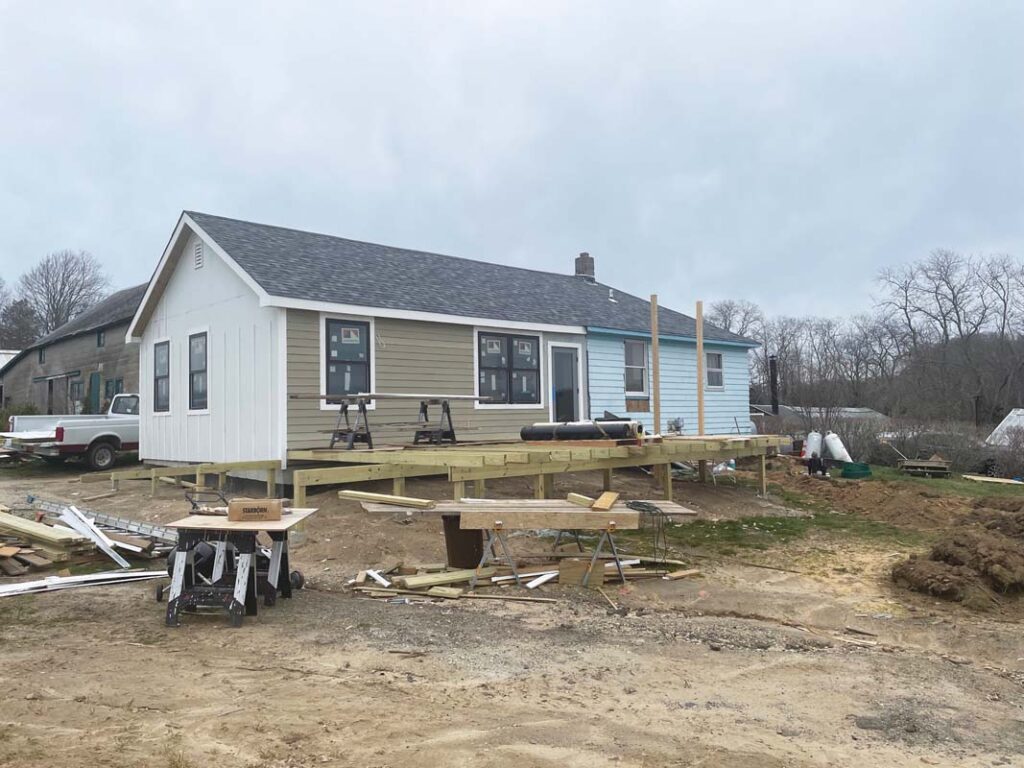Nassau Point property owners hire hunters to reduce deer population

One North Fork community is collectively enlisting the help of a hunting organization to reduce the deer population — a decision that is often left up to individual hunters and homeowners.
For years, a growing deer population on the East End has been blamed for problems such as diminishing woodlands and the destruction of agricultural crops, car accidents and the spread of ticks that carry illnesses such as Lyme disease.
This is the second year the Nassau Point Property Owner’s Association in Cutchogue is working with Hamilton Archers Inc., a nonprofit group of volunteer and recreational hunters, to manage the deer population in its community.
“Nassau Point is overrun by deer and has been for many years,” said Arnold Blair, the association’s chairperson of the deer committee.
Several years ago, the association secured a deer damage permit, or “nuisance” permit, from the New York State Department of Environmental Conservation, Mr. Blair said. There was a “great concern” for health issues related to tick-borne illnesses, car accidents and deer eating away gardens and destroying the understory in the heavily wooded community, he said.
Mr. Blair said several property owners on his street have put up deer fences as protection.
The permit allows deer management activities to take place outside the recreational hunting season in Suffolk County, which runs from Oct. 1 to Jan. 1 for bowhunting and Jan. 7 to 31 for shotgun hunting. It also permits non-hunting methods for antlerless deer only, such as shooting at night, use of bait and capture-and-kill methods, according to the DEC.

Nassau Point property owners had previously hired sharpshooters from the U.S. Department of Agriculture, who set up cameras and bait stations and were successful for a few years, Mr. Blair said. But after a while, “it was sort of the law of diminishing returns,” he said, adding that hiring the USDA proved expensive.
Mr. Blair said he wondered at that point if Nassau Point should try deer management through the recreational hunting season. To that end, he was introduced to Jim Edwards, founder of Hamilton Archers.
“There’s great support from the community, which is a key factor,” Mr. Blair said. About 80 property owners have volunteered their land for hunting.
The archers don’t hunt on every single property, but having the landowners’ go-ahead to do so makes a difference.
“Access to deer is one of the biggest obstacles to reducing deer numbers in Suffolk County,” DEC wildlife biologist Dr. Sue Booth-Binczik said at a county Tick Control Advisory Committee meeting Friday.
This is because most of the land on which deer could be hunted is privately owned, she said. The DEC requires a 150-foot setback from homes during hunting season in non-permitted communities.
The issue isn’t a lack of willing hunters, she said.
“It would be much more productive to motivate landowners to allow hunting on their land,” Dr. Booth-Binczik said. She noted there are other obstacles in the form of hunting restrictions in Suffolk County, including the inability to hunt with crossbows.
Deer population growth has occurred largely in the state’s urban and suburban areas, she said. Suburban development doesn’t destroy their habitat, but creates it, she said, because they find food in yards and gardens, as well as the “patchy” spaces they like.
A low natural mortality rate in suburbs combined with the high reproductive rate of deer creates “phenomenally high” densities, she said.
On Shelter Island, a recent survey showed that 72 percent of respondents “support the town contracting with appropriately trained/licensed personnel to reduce deer density,” while 57 percent said they would allow hunting on their own properties.
Six deer were taken in the first week of this season on Nassau Point, Mr. Blair said.
Those who hunt with Hamilton Archers either harvest the deer for their own use or give the meat away to friends or to Southold Town’s venison donation program, Mr. Edwards said. This year the organization is working on about 12 properties on Nassau Point.
Mr. Edwards, who described himself as a purist who prefers traditional bowhunting, explained that Hamilton Archers uses technology to their advantage by setting up cameras on trees that take a picture when a deer crosses its path. This allows them to be more effective by not spending time where there are not a lot of deer, he said.
Mr. Edwards said he believes an organized deer management effort is more effective than having a “free-for-all” of individual hunters. He said he hopes Nassau Point can act as a model for other communities, he said.
Most of the volunteer hunters live locally and have full-time jobs, Mr. Edwards said. The organization also conducts outreach to veterans to join their efforts, he said.
“We’re there because we enjoy it, but we also understand that the herd does need to be brought down,” Mr. Edwards said. “We understand that if we don’t step up and do it as recreational hunters, eventually the town or the government is going to be forced to take more extreme measures.”
CORRECTION: Arnold Blair is the chairperson of the deer committee, not the president of the NPPOA.
Top photo: Hamilton Archers founder Jim Edwards (left) and Derek Grattan of Southold before they set out Monday to hunt on Nassau Point. (Credit: Kelly Zegers)









